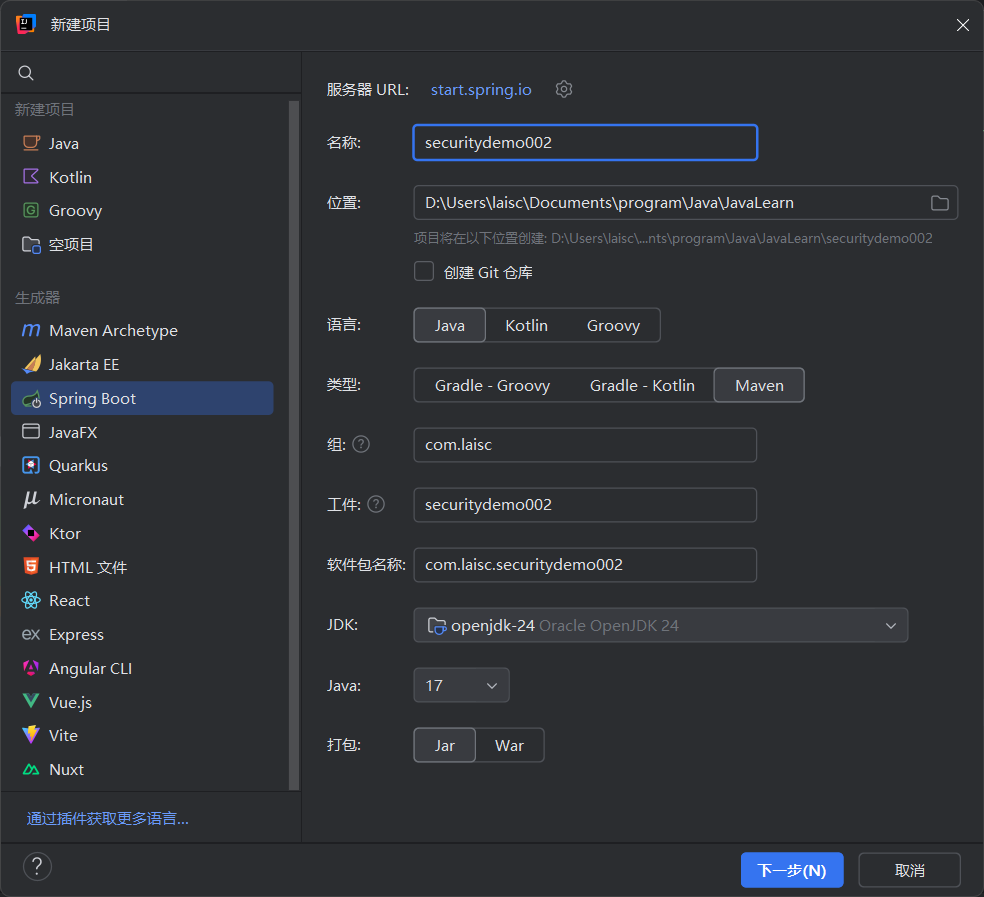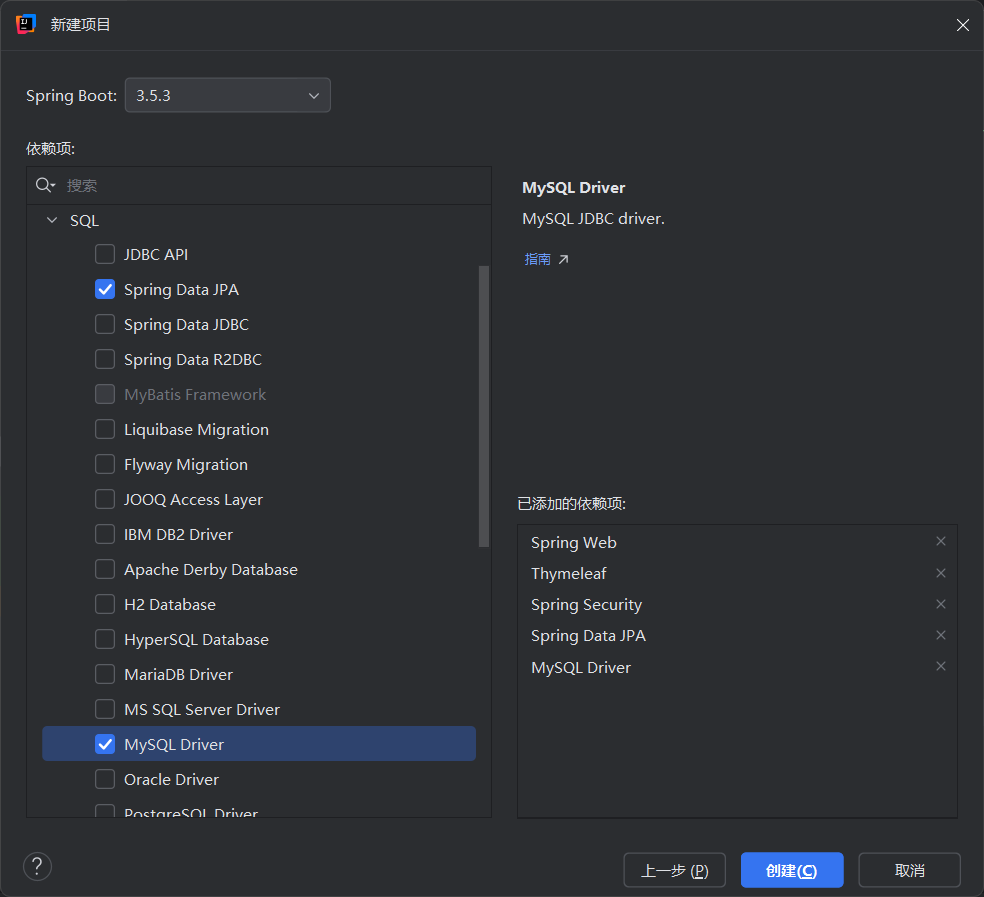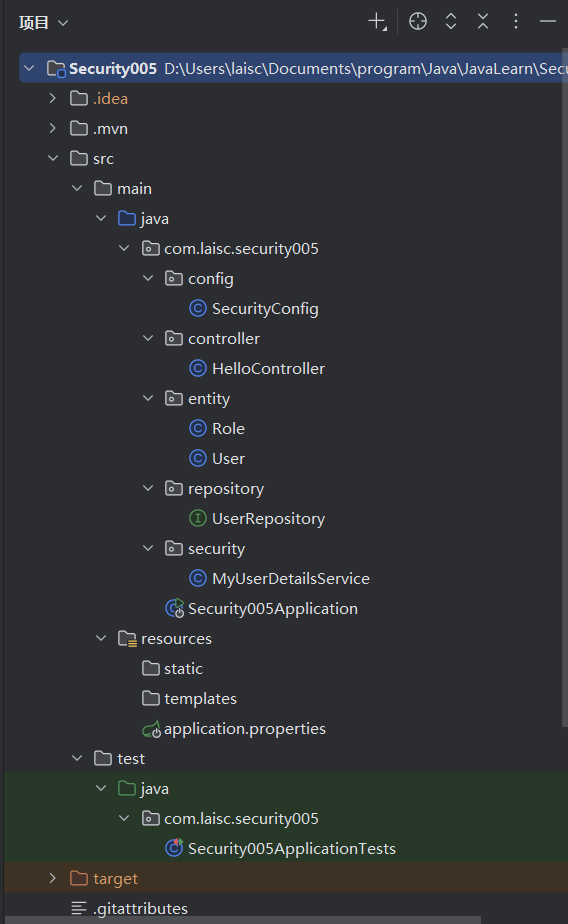建立项目:


这是完成后的目录结构:

源代码:
SecurityConfig.java
1
2
3
4
5
6
7
8
9
10
11
12
13
14
15
16
17
18
19
20
21
22
23
24
25
26
27
28
29
30
31
32
33
34
35
36
37
38
39
40
41
42
43
44
45
46
47
48
49
50
51
52
53
54
55
56
57
58
59
60
61
62
63
64
65
66
67
68
69
| package com.laisc.securitydemo002.config;
import com.laisc.securitydemo002.security.MyUserDetailsService;
import org.springframework.beans.factory.annotation.Autowired;
import org.springframework.context.annotation.Bean;
import org.springframework.context.annotation.Configuration;
import org.springframework.security.config.annotation.web.builders.HttpSecurity;
import org.springframework.security.web.SecurityFilterChain;
@Configuration
public class SecurityConfig {
@Autowired
private MyUserDetailsService userDetailsService;
@Bean
public SecurityFilterChain filterChain(HttpSecurity http) throws Exception {
http
.authorizeHttpRequests(auth -> auth
.requestMatchers("/admin").hasRole("ADMIN")
.requestMatchers("/hello").hasAnyRole("USER", "ADMIN")
.anyRequest().authenticated()
)
.formLogin()
.and()
.userDetailsService(userDetailsService);
return http.build();
}
}
|
HelloController.java
1
2
3
4
5
6
7
8
9
10
11
12
13
14
15
16
17
18
19
20
21
| package com.laisc.securitydemo002.controller;
import org.springframework.stereotype.Controller;
import org.springframework.web.bind.annotation.RequestMapping;
import org.springframework.web.bind.annotation.ResponseBody;
@Controller
public class HelloController {
@ResponseBody
@RequestMapping("/hello")
public String hello() {
return "Hello, Spring Security!";
}
@ResponseBody
@RequestMapping("/admin")
public String admin() {
return "Admin Area!";
}
}
|
Role.java
1
2
3
4
5
6
7
8
9
10
11
12
13
14
15
16
17
18
19
20
21
22
23
24
25
26
27
28
29
30
31
32
33
34
35
36
37
38
39
40
41
42
43
44
45
| package com.laisc.securitydemo002.entity;
import jakarta.persistence.*;
import java.util.HashSet;
import java.util.Set;
@Entity
@Table(name = "roles")
public class Role {
@Id
@GeneratedValue(strategy = GenerationType.IDENTITY)
private Long id;
private String name;
@ManyToMany(mappedBy = "roles")
private Set<User> users = new HashSet<>();
public Long getId() {
return id;
}
public void setId(Long id) {
this.id = id;
}
public String getName() {
return name;
}
public void setName(String name) {
this.name = name;
}
public Set<User> getUsers() {
return users;
}
public void setUsers(Set<User> users) {
this.users = users;
}
}
|
User.java
1
2
3
4
5
6
7
8
9
10
11
12
13
14
15
16
17
18
19
20
21
22
23
24
25
26
27
28
29
30
31
32
33
34
35
36
37
38
39
40
41
42
43
44
45
46
47
48
49
50
51
52
53
54
55
56
57
58
59
60
61
62
63
64
65
66
67
| package com.laisc.securitydemo002.entity;
import jakarta.persistence.*;
import java.util.HashSet;
import java.util.Set;
@Entity
@Table(name = "users")
public class User {
@Id
@GeneratedValue(strategy = GenerationType.IDENTITY)
private Long id;
private String username;
private String password;
private boolean enabled;
@ManyToMany(fetch = FetchType.EAGER)
@JoinTable(
name = "user_roles",
joinColumns = @JoinColumn(name = "user_id"),
inverseJoinColumns = @JoinColumn(name = "role_id")
)
private Set<Role> roles = new HashSet<>();
public Long getId() {
return id;
}
public void setId(Long id) {
this.id = id;
}
public String getUsername() {
return username;
}
public void setUsername(String username) {
this.username = username;
}
public String getPassword() {
return password;
}
public void setPassword(String password) {
this.password = password;
}
public boolean isEnabled() {
return enabled;
}
public void setEnabled(boolean enabled) {
this.enabled = enabled;
}
public Set<Role> getRoles() {
return roles;
}
public void setRoles(Set<Role> roles) {
this.roles = roles;
}
}
|
UserRepository.java
1
2
3
4
5
6
7
8
9
10
11
| package com.laisc.securitydemo002.repository;
import com.laisc.securitydemo002.entity.User;
import org.springframework.data.jpa.repository.JpaRepository;
import java.util.Optional;
public interface UserRepository extends JpaRepository<User, Long> {
Optional<User> findByUsername(String username);
}
|
MyUserDetailsService.java
1
2
3
4
5
6
7
8
9
10
11
12
13
14
15
16
17
18
19
20
21
22
23
24
25
26
27
28
29
30
31
32
33
34
35
36
37
| package com.laisc.securitydemo002.security;
import com.laisc.securitydemo002.entity.User;
import com.laisc.securitydemo002.repository.UserRepository;
import org.springframework.beans.factory.annotation.Autowired;
import org.springframework.security.core.authority.SimpleGrantedAuthority;
import org.springframework.security.core.userdetails.UserDetails;
import org.springframework.security.core.userdetails.UserDetailsService;
import org.springframework.security.core.userdetails.UsernameNotFoundException;
import org.springframework.stereotype.Service;
import java.util.stream.Collectors;
@Service
public class MyUserDetailsService implements UserDetailsService {
@Autowired
private UserRepository userRepository;
@Override
public UserDetails loadUserByUsername(String username) throws UsernameNotFoundException {
User user = userRepository.findByUsername(username)
.orElseThrow(() -> new UsernameNotFoundException("用户不存在"));
return new org.springframework.security.core.userdetails.User(
user.getUsername(),
user.getPassword(),
user.isEnabled(),
true, true, true,
user.getRoles().stream()
.map(role -> new SimpleGrantedAuthority(role.getName()))
.collect(Collectors.toList())
);
}
}
|
Securitydemo002Application.java
1
2
3
4
5
6
7
8
9
10
11
12
13
14
15
| package com.laisc.securitydemo002;
import org.springframework.boot.SpringApplication;
import org.springframework.boot.autoconfigure.SpringBootApplication;
@SpringBootApplication
public class Securitydemo002Application {
public static void main(String[] args) {
SpringApplication.run(Securitydemo002Application.class, args);
System.out.println("ok!");
}
}
|
application.properties
1
2
3
4
5
6
7
8
9
10
11
12
13
14
15
16
17
18
19
20
21
22
23
24
25
26
27
28
29
| spring.application.name=securitydemo002
server.port=8001
spring.datasource.url=jdbc:mysql://localhost:3306/test005?useSSL=false&serverTimezone=UTC
spring.datasource.username=root
spring.datasource.password=your_mysql_password
spring.datasource.driver-class-name=com.mysql.cj.jdbc.Driver
spring.jpa.hibernate.ddl-auto=update
spring.jpa.show-sql=true
spring.jpa.properties.hibernate.dialect=org.hibernate.dialect.MySQL8Dialect
|
初始化数据库:
1
2
3
4
5
6
7
8
9
10
11
12
13
14
15
16
17
18
19
20
21
22
| CREATE DATABASE test_db CHARACTER SET utf8mb4;
CREATE TABLE users (
id BIGINT PRIMARY KEY AUTO_INCREMENT,
username VARCHAR(50) NOT NULL UNIQUE,
password VARCHAR(100) NOT NULL,
enabled BOOLEAN DEFAULT TRUE
);
CREATE TABLE roles (
id BIGINT PRIMARY KEY AUTO_INCREMENT,
name VARCHAR(50) NOT NULL UNIQUE
);
CREATE TABLE user_roles (
user_id BIGINT,
role_id BIGINT,
PRIMARY KEY (user_id, role_id),
FOREIGN KEY (user_id) REFERENCES users(id),
FOREIGN KEY (role_id) REFERENCES roles(id)
);
|
初始化数据:
1
2
3
4
5
6
7
8
|
INSERT INTO users(username, password) VALUES ('user', '{noop}123456');
INSERT INTO users(username, password) VALUES ('admin', '{noop}admin123');
INSERT INTO roles(name) VALUES ('ROLE_USER'), ('ROLE_ADMIN');
INSERT INTO user_roles(user_id, role_id) VALUES (1, 1), (2, 2);
|
完成!


